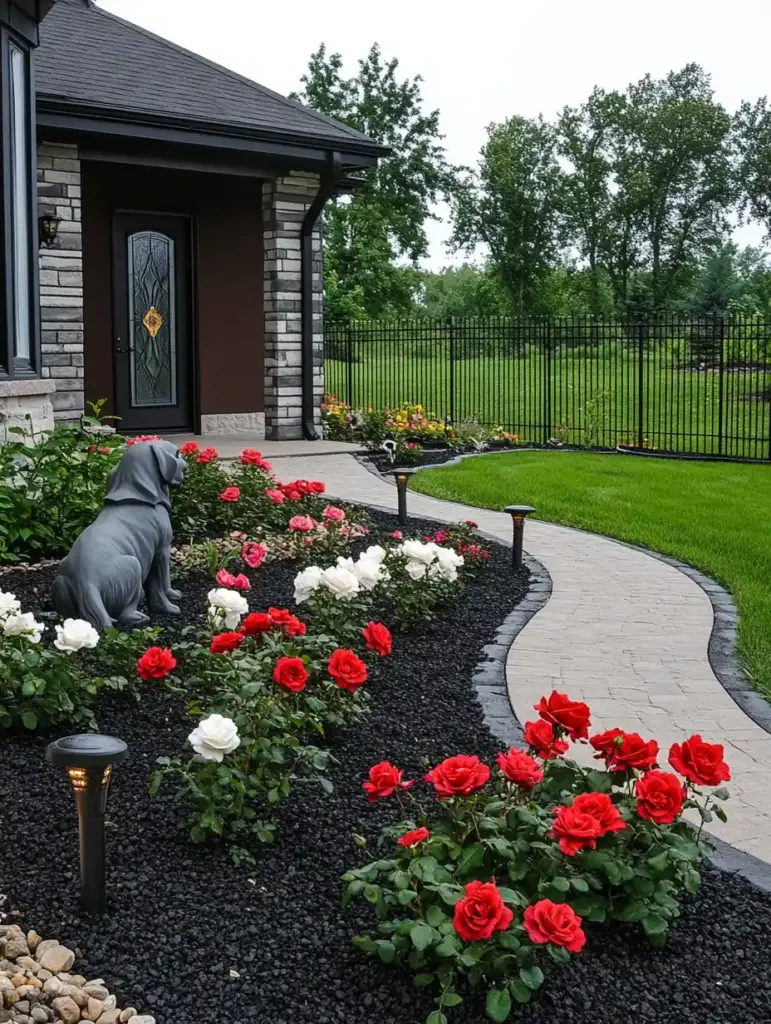A well-designed flower bed can instantly elevate your home’s curb appeal, turning an ordinary front yard into a vibrant, welcoming space. By thoughtfully selecting colorful blooms and pairing them with creative layouts, you can add both character and charm that reflects your personal gardening style.
Even a compact front yard can shine with the right design — from small garden layouts to clever use of containers or vertical planters. Whether you’re drawn to classic perennials or prefer a more modern touch, there’s a flower garden idea that’s perfect for your home.
Let’s dive into 15 simple and inspiring ways to design a standout flower bed for the front of your house.
Table of Contents
15 Easy Flower Bed Ideas to Boost Front Yard Appeal
🌸 1. Walkway Flower Bed: A Blooming Path to Your Door
A flower bed along your walkway doesn’t just add beauty — it guides the eye and gently leads guests toward your home. This simple upgrade can dramatically enhance curb appeal with minimal effort.
Design Tips:
- Complement the walkway, don’t overcrowd it. Keep plantings neat and slightly set back from the path to maintain flow and accessibility.
- Choose fragrant flowers like lavender, roses, or jasmine to create an aromatic experience as guests approach.
- Use hardscape elements such as stone or brick edging to define the border and prevent soil from spilling onto the walkway.
- Vary plant heights slightly to add dimension, using low-growing blooms like alyssum near the edge and medium-height perennials further back.
💡 Pro Tip: Integrate solar-powered path lights for a soft glow that highlights your flower bed at night while keeping the walkway safe and inviting.
🌺 2. Colorful Flower Wall: Vertical Beauty for Small Spaces
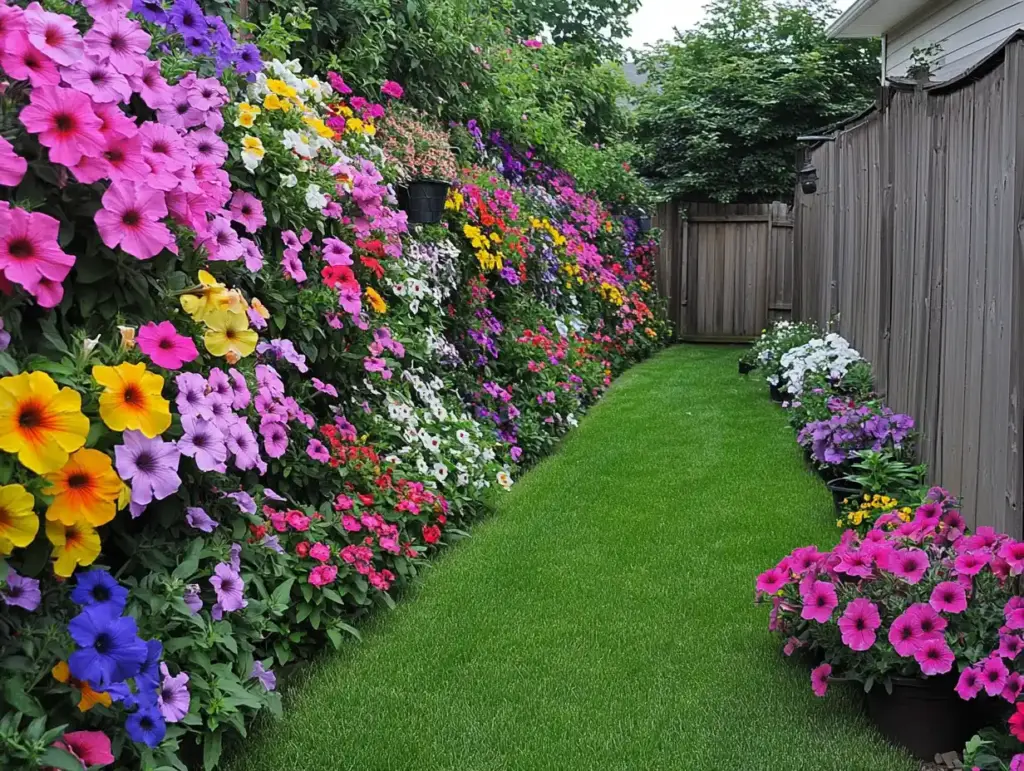
When ground space is limited, think vertically. A colorful flower wall adds a lush layer of life to fences, house walls, or even porch railings — all while saving precious square footage.
Creative Vertical Garden Ideas:
- Use trellises, wall planters, or hanging pockets to create structured flower walls.
- Ideal flower choices include clematis, wisteria, lobelia, and bougainvillea — all known for their cascading or climbing growth habits.
- Mix in green foliage like ivy or ferns for texture, or herbs like mint and basil for a touch of practicality.
- For a dynamic effect, layer different plant heights and bloom times to maintain consistent interest.
🎨 Design Tip: Match your flower color palette with your home’s exterior. Warm hues like orange or red pop against cool-toned siding, while pastel shades soften brick or stone backdrops.
🌻 3. Circular Flower Bed with Centerpiece: Symmetry Meets Statement
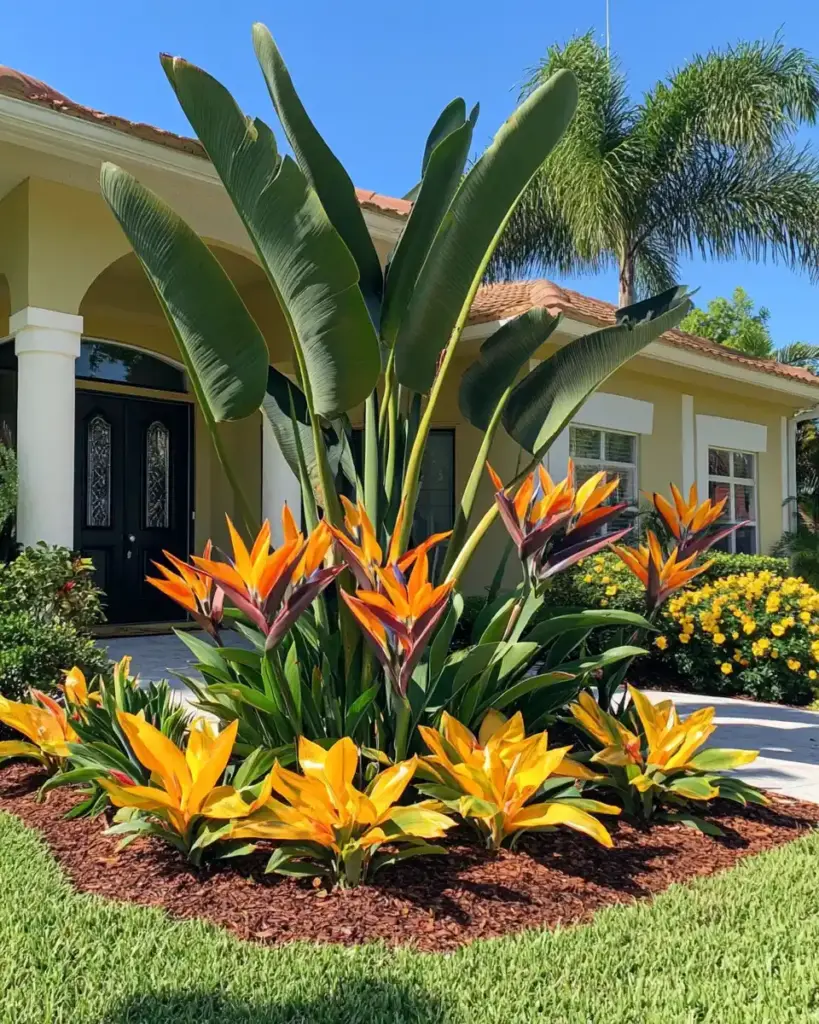
A circular flower bed adds a sense of structure and balance to your front yard while drawing attention to a standout centerpiece. It’s a timeless design that works well in both formal and casual landscapes.
How to Build It:
- Start by selecting a centerpiece such as an ornamental tree (like Japanese maple), a striking grass variety, a birdbath, a small fountain, or a sculpture.
- Arrange flowers in radiating rings around the centerpiece for a formal, symmetrical look — or go for a more relaxed, organic scatter to give a cottage-garden feel.
- Use color layering: taller blooms like snapdragons or salvia toward the middle, then medium-height fillers like geraniums, and finish with edging plants like alyssum or creeping phlox.
- Consider surrounding the bed with stone, brick, or metal edging to keep the shape tidy and define the area.
🌿 Garden Insight: Circular beds work especially well in open lawns or at focal points near driveways or porch steps where they can be appreciated from all sides.
🌷 4. Raised Flower Bed with Seating: Beauty and Function Combined
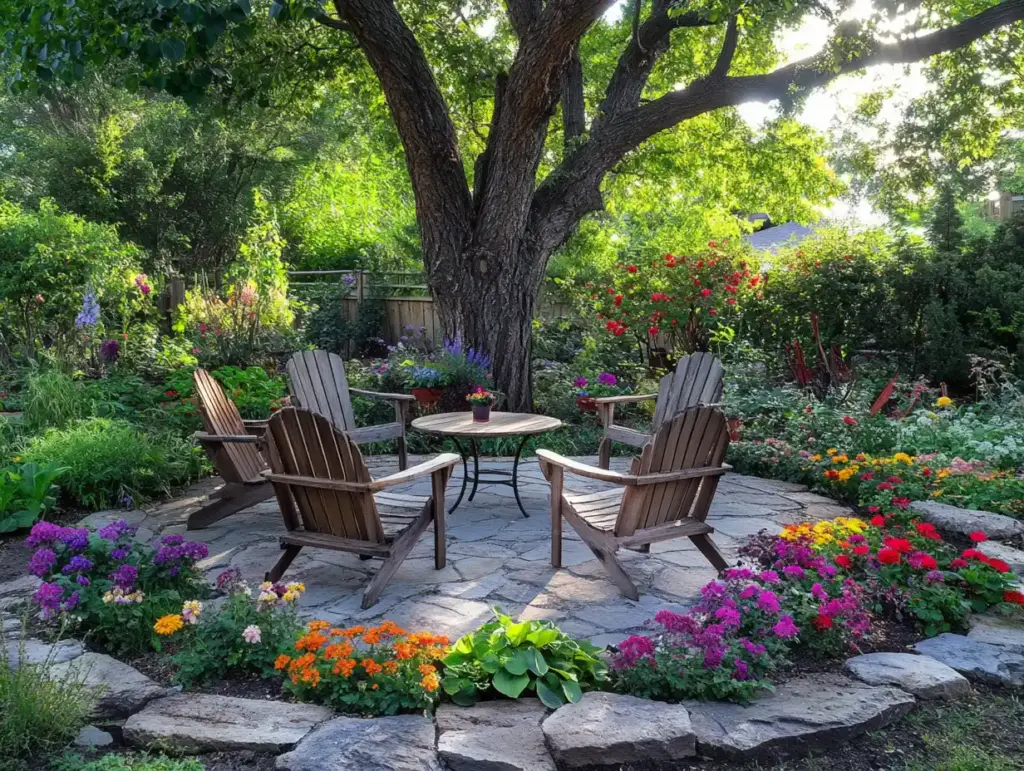
A raised flower bed with built-in seating is a clever way to merge form and function in your front yard. Not only does it elevate your flowers — quite literally — but it also offers a cozy spot to sit and admire them.
Design Considerations:
- Construct the bed from durable materials like stone, brick, or pressure-treated wood. Choose finishes that complement your home’s façade.
- Build the wall height between 18–24 inches to double as comfortable seating.
- Incorporate tiered planting within the bed: place trailing flowers like nasturtium or sweet potato vine along the edges, medium blooms in the middle, and taller structural plants at the back.
- Add freestanding benches or even a curved built-in bench for a more cohesive, integrated design.
🪴 Bonus Tip: Include a few fragrant plants such as lavender or rosemary near the seating area — you’ll enjoy both the scent and the view while relaxing.
🌼 5. Tiered Flower Bed: Add Height and Drama to Your Garden
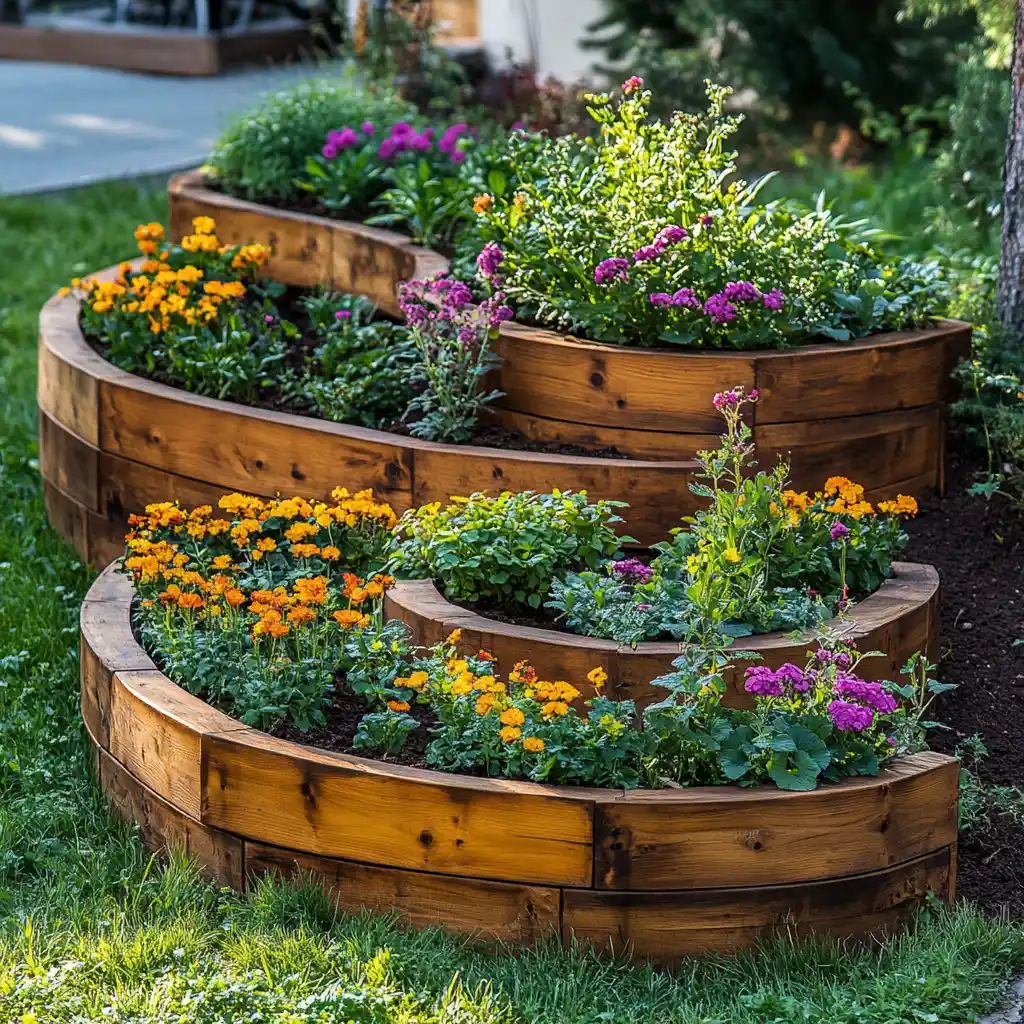
A tiered flower bed creates visual interest and maximizes planting space by layering flowers at different heights. It’s perfect for sloped yards or as a striking feature in flat front lawns.
How to Build a Tiered Flower Bed:
- Use wooden planters, stone terraces, or stacked containers to create 2–4 levels.
- Arrange plants by height: tall ornamental grasses or sunflowers at the back, mid-sized blooms like echinacea or black-eyed susans in the middle, and groundcovers such as creeping thyme or lobelia in the front.
- For added drama, choose cascading plants like trailing petunias, verbena, or ivy to spill over the edges.
- Mix plant textures and bloom times for year-round appeal and consistent layering.
🌱 Smart Planning: Install drip irrigation or self-watering containers to keep maintenance manageable — water naturally flows from top to bottom in tiered beds.
🌳 6. Tree Base Flower Bed: From Bare to Beautiful
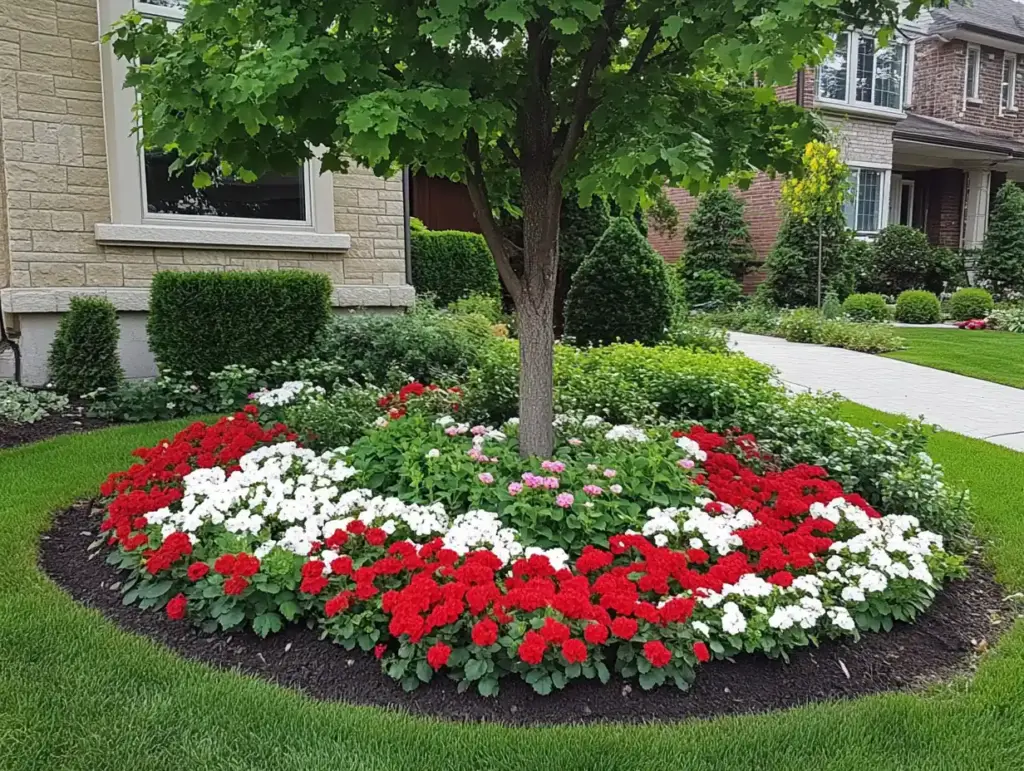
The space around trees is often overlooked, but turning the base into a flower bed can create a lovely focal point and unify your front yard landscape.
Steps to Transform Tree Bases:
- Use shade-tolerant plants such as hostas, impatiens, begonias, and ferns. These thrive under the dappled canopy of most front-yard trees.
- Follow a radial layout, planting in rings or gentle spirals that echo the natural shape of the tree’s canopy.
- Add a natural edge with river stones, mulch, or metal landscape borders to protect roots and define the bed.
- Avoid planting too close to the tree trunk and don’t dig deep, as tree roots are sensitive and close to the surface.
🍂 Eco Tip: Mulch generously to retain moisture, reduce weeds, and protect shallow roots — all while making your flower bed look tidy and complete.
🌸 7. Vibrant Hanging Flower Bed: Elevate Your Floral Display
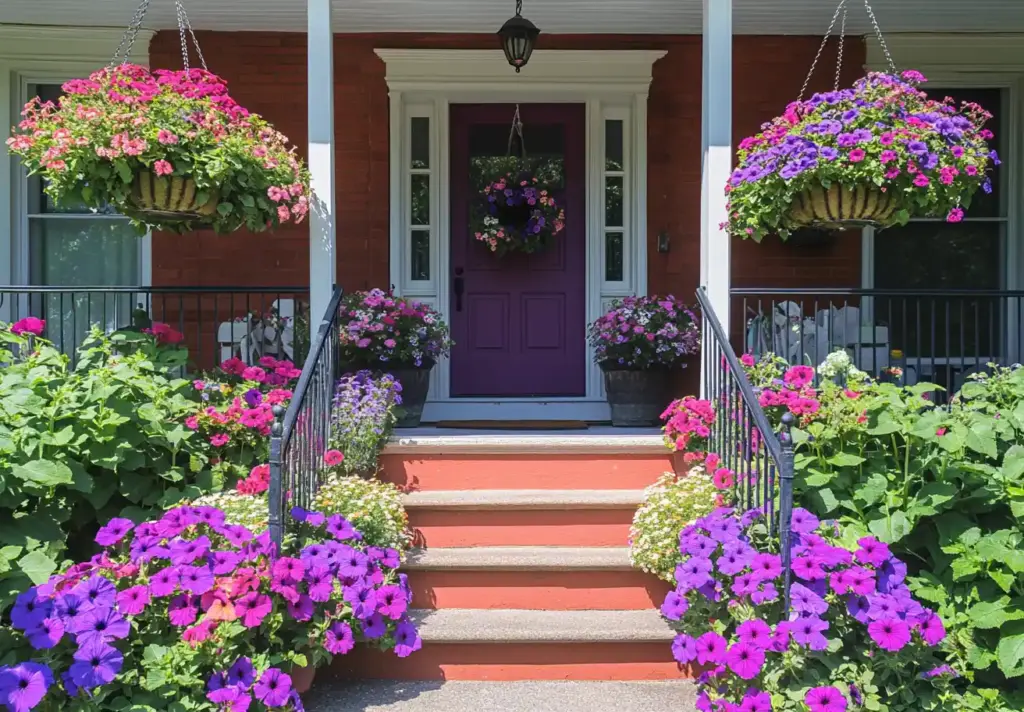
A hanging flower bed is a charming way to bring color and greenery to your front porch, pergola, or fence — especially if ground space is limited. With the right mix of trailing plants and creative containers, you can turn any vertical surface into a living work of art.
Design Ideas for Hanging Flower Beds:
- Use hanging baskets, wall planters, or railing boxes to add vertical interest.
- Combine trailing flowers like petunias, lobelia, bacopa, and verbena for a cascading effect.
- Mix in foliage plants like ivy, sweet potato vine, or dusty miller for added texture.
- If space allows, include herbs like thyme, mint, or basil for a functional and fragrant touch.
🌿 Pro Tip: Stagger hanging heights and angles to create depth and dimension, especially if you’re placing multiple baskets along a porch or wall.
🪴 8. Potted Flower Bed: Flexible and Stylish Floral Arrangements
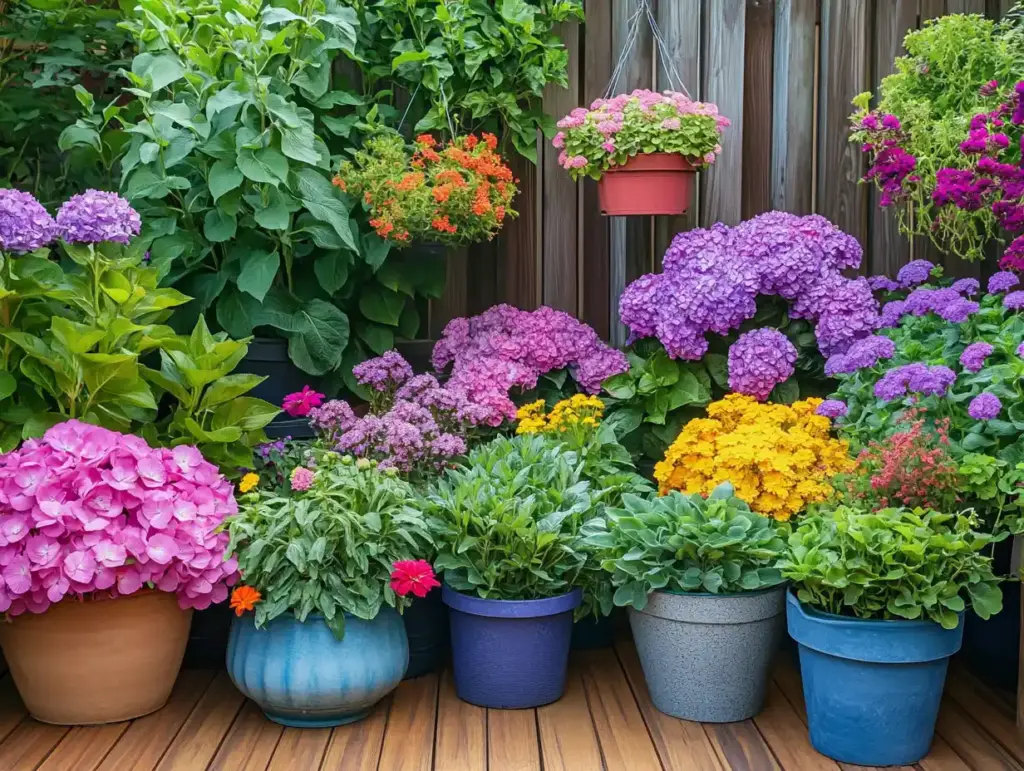
If you’re working with limited ground space or want the freedom to rearrange your garden with the seasons, a potted flower bed is a versatile and eye-catching solution. Grouping containers near your entryway, walkway, or patio adds personality and color exactly where you need it.
How to Build a Potted Flower Bed:
- Select containers of varying sizes, materials, and heights for a layered look.
- Group pots based on the sunlight and water needs of the plants to ensure they thrive together.
- Use thriller-filler-spiller planting technique:
- Thrillers: tall focal plants (like ornamental grasses or canna lilies)
- Fillers: mid-height blooms (like geraniums or marigolds)
- Spillers: trailing plants (like sweet alyssum or creeping Jenny)
- Rotate your container flowers seasonally for year-round color and freshness.
🌸 Flexibility Bonus: Move pots to sunnier spots as needed or cluster them for impact during special occasions.
🪨 9. River Rock Flower Bed: Low-Maintenance Meets Natural Charm
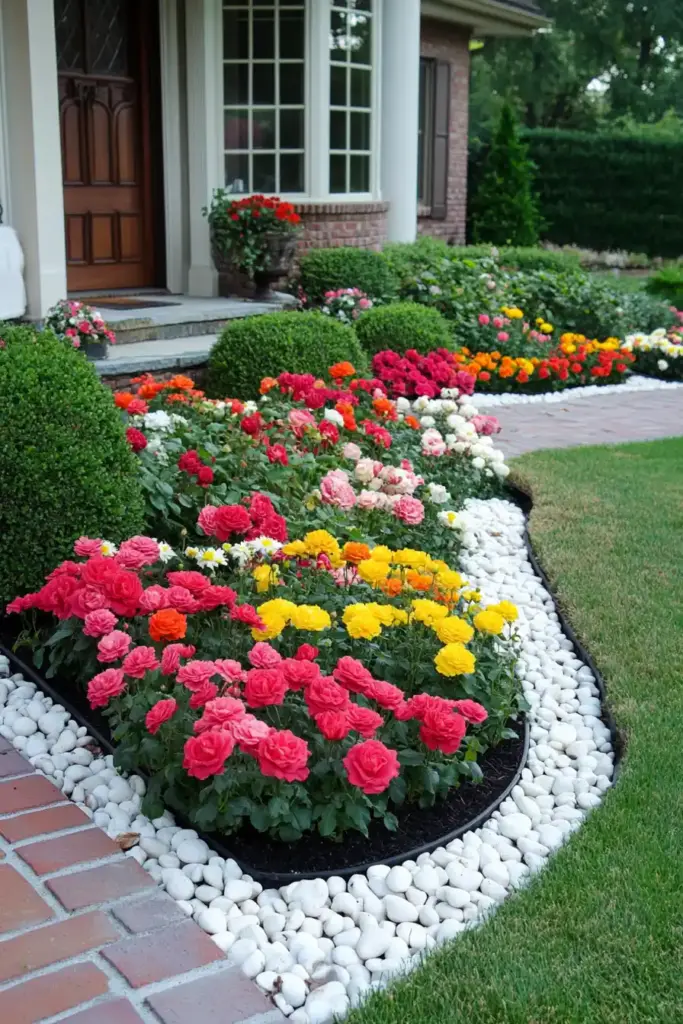
A river rock flower bed blends rugged textures with soft blooms, creating a visually striking contrast while keeping maintenance to a minimum. This is an ideal choice for homeowners seeking a polished yet earthy look.
Steps to Create a River Rock Flower Bed:
- Begin by laying down landscape fabric to suppress weeds.
- Spread a layer of river rocks — choose colors and sizes that complement your house and other landscaping.
- Cut holes in the fabric to plant drought-tolerant flowers such as coreopsis, black-eyed susan, or blanket flower.
- For extra texture, add succulents, ornamental grasses, or low-growing evergreens between rock sections.
💧 Water-Wise Tip: Because river rock beds retain less moisture, pair them with hardy, low-water plants to create a sustainable and easy-to-care-for garden space.
🎨 10. Play with Flower Colors: Design with Intent and Impact
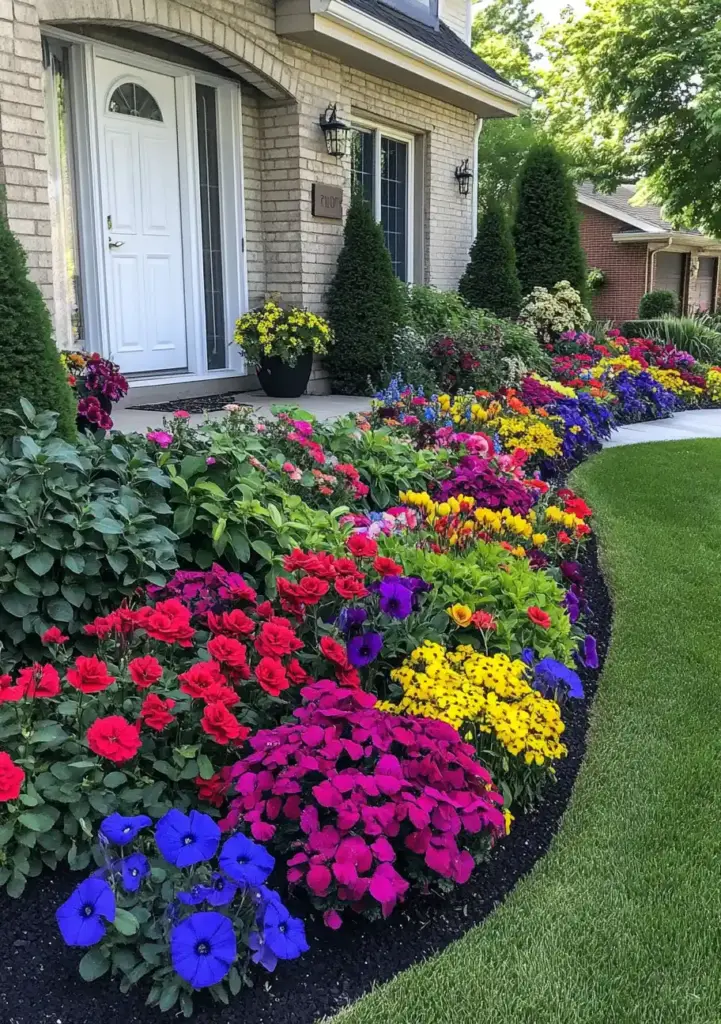
Color is one of the most powerful tools in garden design. A well-thought-out flower bed color scheme can evoke emotion, create harmony, or make bold statements — all while enhancing your home’s exterior.
Color Strategy Tips:
- Monochromatic designs use varying shades of one color (like all pinks or purples) for a calm, cohesive look.
- Complementary colors (such as yellow and purple or red and green) offer bold contrast that makes each flower pop.
- Use analogous color schemes (like orange, red, and yellow) for a warm, sunset-inspired palette.
- Always consider your home’s exterior tone — warm-colored houses benefit from cooler flowers and vice versa.
🌺 Balance Tip: Mix in green foliage to break up strong color blocks and keep the bed from looking overly busy or chaotic.
🌲 11. Log Flower Bed: Rustic Charm with an Eco-Friendly Twist
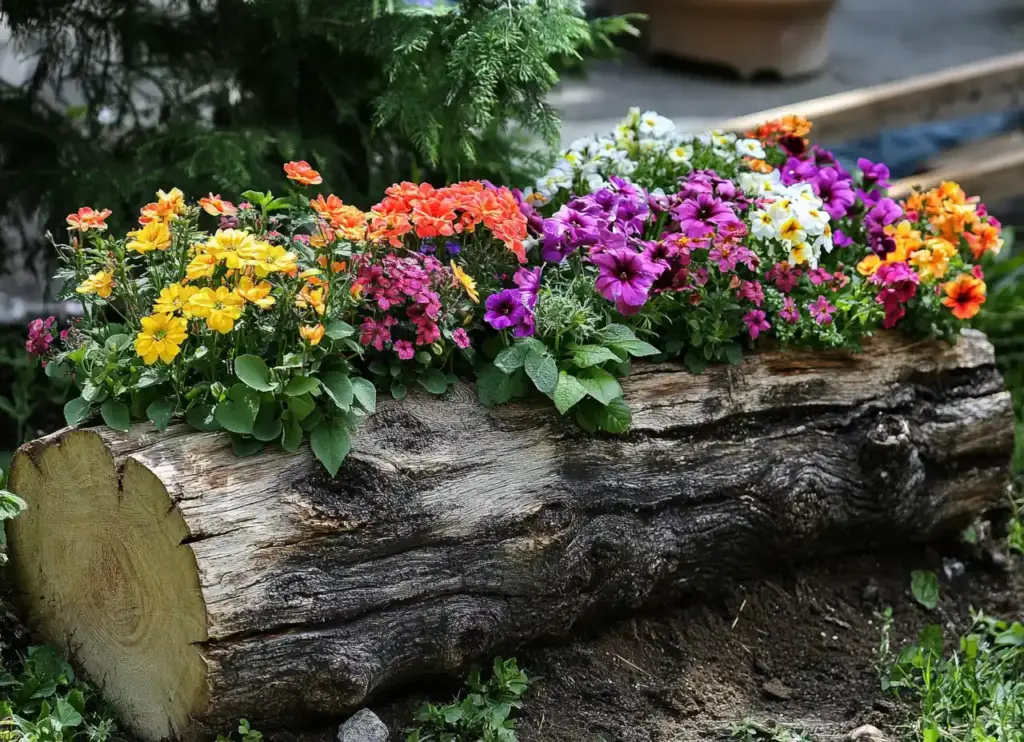
A log flower bed is a creative and sustainable way to bring rustic character to your front yard. By repurposing hollowed-out logs, you can craft a natural planter that blends beautifully with the landscape.
Steps to Build a Log Flower Bed:
- Choose solid, pest-free logs (hardwoods work best) and cut to the desired length.
- Hollow out the center using a chainsaw or chisel, leaving at least 2–3 inches of wood on all sides.
- Drill drainage holes at the bottom to prevent water buildup.
- Line the inside with landscape fabric (optional), then fill with well-draining potting mix.
- Plant colorful annuals like pansies, begonias, or petunias — or try a mix of succulents and herbs for texture.
🌿 Preservation Tip: Apply a non-toxic wood sealant to the exterior of the log to help resist decay and extend its life outdoors.
🛞 12. Wheelbarrow Flower Bed: Vintage Charm on Wheels
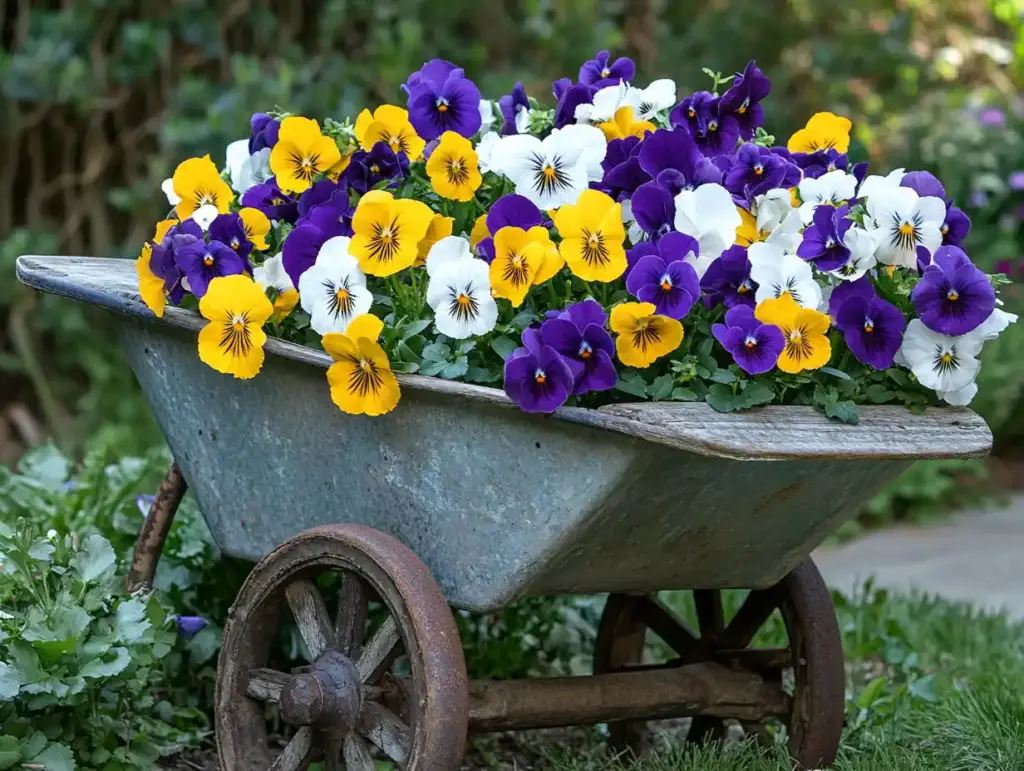
A wheelbarrow flower bed brings nostalgic character and mobility to your front yard garden. It’s a fun and functional way to showcase your favorite blooms while making a strong visual statement.
How to Repurpose a Wheelbarrow:
- Use an old metal or wooden wheelbarrow with a flat, sturdy base. Clean it thoroughly and drill several drainage holes in the bottom.
- Line with landscape fabric if desired, then fill with a lightweight potting mix.
- Arrange your flower bed using the thriller-filler-spiller method for layered beauty.
- Choose cheerful annuals like marigolds, zinnias, or calibrachoa that bloom throughout the season.
🎡 Placement Tip: Set your wheelbarrow in a high-visibility spot like near the walkway or porch — or move it seasonally to refresh your curb appeal instantly.
🛞 13. Repurposed Tire Flower Bed: Eco-Friendly and Full of Personality

A repurposed tire flower bed is a playful, environmentally conscious way to add creativity and color to your front yard. Old tires — from cars, bikes, or trucks — can be transformed into eye-catching planters that showcase your gardening flair.
How to Make One:
- Clean the tires thoroughly and drill drainage holes if using them flat on the ground.
- Paint them with weather-resistant spray paint in bright or pastel tones — or decorate with stencils for added flair.
- Stack tires for height, hang them on fences, or set them side by side for a tiered look.
- Fill with potting soil and plant low-maintenance blooms like petunias, impatiens, or daisies.
♻️ Creative Variation: Cut the top sidewall into petal shapes for a flower-inspired silhouette that doubles as a statement piece.
🌊 14. Wavy Flower Bed: Natural Movement and Flow
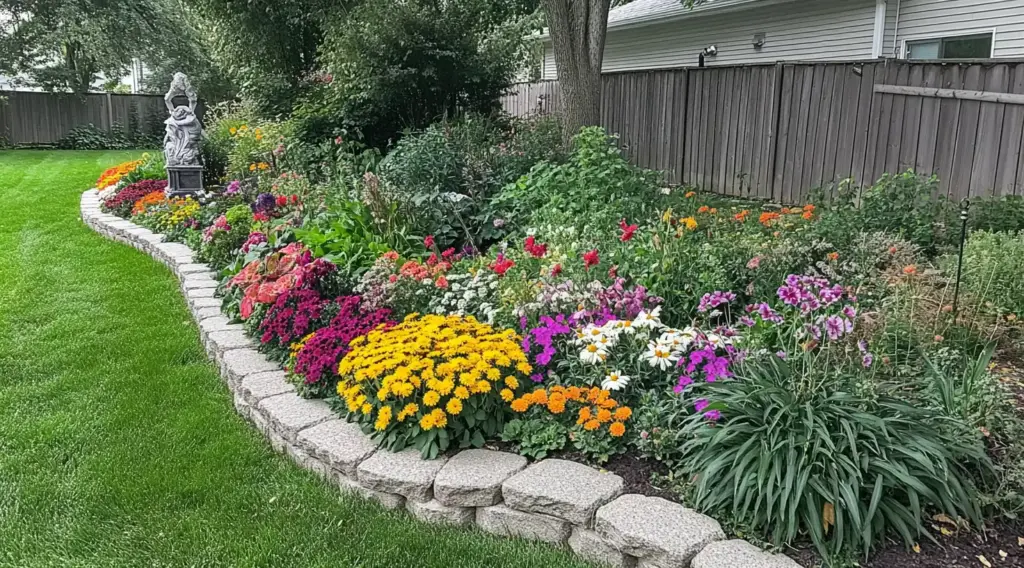
A wavy flower bed breaks free from rigid lines and formal layouts, mimicking the soft curves found in nature. This design adds a sense of motion and whimsy to your front yard, making it feel more relaxed and organic.
Designing a Wavy Flower Bed:
- Outline your bed with a garden hose first to experiment with natural curves before committing.
- Use a mix of soft-edged plants like ornamental grasses, salvia, and daylilies to complement the flowing shape.
- Alternate colors and textures to create visual rhythm as the eye follows the bed’s curves.
- Choose a natural edging material like stone or mulch to maintain the flow and prevent a jarring transition to lawn.
🍃 Maintenance Note: Wavy edges require a bit more care when mowing or edging, but the added visual interest is well worth the extra effort.
🌼 15. Seasonal Flower Bed Rotation: Year-Round Color and Freshness
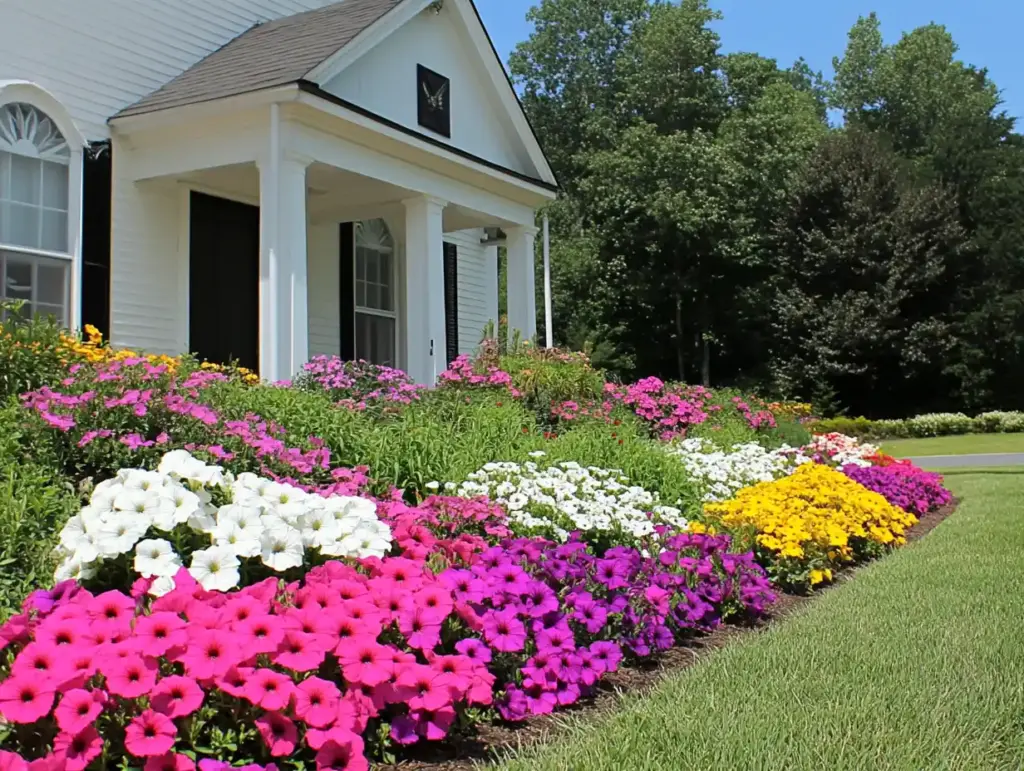
Keeping your flower bed vibrant through all four seasons is easier than you think — it just takes a little planning. By rotating flowers based on their bloom time, you can maintain color, texture, and interest throughout the year.
Seasonal Planting Guide:
🌸 Spring
- Early bloomers: Tulips, daffodils, hyacinths
- Cool-season annuals: Violas, pansies, snapdragons
☀️ Summer
- Heat-tolerant annuals: Marigolds, zinnias, cosmos
- Reliable perennials: Coneflowers, black-eyed susans, daylilies
🍁 Fall
- Late bloomers: Asters, sedums, ornamental kale
- Foliage interest: Heuchera, Japanese maples
❄️ Winter
- Cold-hardy options: Hellebores, witch hazel, ornamental cabbage
- Add structure with evergreen shrubs or dried ornamental grasses
🗓 Pro Tip: Create a planting calendar for your zone to make seasonal swaps smoother — and use containers or movable pots for extra flexibility.
❓ Flower Bed FAQs
What is the easiest flower bed to maintain?
A raised flower bed or a potted flower bed is often the easiest to maintain. These options offer better soil control, reduce weed growth, and allow easier access for watering and pruning.
How do I choose the best location for a flower bed?
Pick a spot that matches your plants’ sunlight and drainage needs. Most flowers prefer 6+ hours of direct sunlight, so the front yard is ideal — especially along walkways or near entryways.
How do I prepare the soil for a new flower bed?
Remove grass or weeds, loosen the soil 6–12 inches deep, and enrich it with compost or organic matter. For containers or raised beds, use a high-quality potting mix.
How can I make my flower bed look full and colorful?
Use a combination of tall, mid-height, and trailing plants, and mix early- and late-blooming flowers to keep color flowing all season. Plant in odd-numbered groups for a natural, balanced look.
Can I make a flower bed without digging?
Yes! Try a no-dig flower bed by layering cardboard over grass, then adding compost and mulch. You can also use containers, repurposed tires, or wheelbarrows for instant beds with zero digging.
🌺 Conclusion: Let Your Flower Bed Tell a Story
A thoughtfully designed flower bed does more than just beautify the front of your house — it invites guests in, reflects your personality, and offers a visual story that changes beautifully with the seasons.
Whether you’re drawn to clean-lined layouts or the flowing charm of organic curves, rustic containers or recycled garden ideas, the possibilities are nearly endless. By incorporating raised beds, seasonal flower rotations, and clever use of space, you can design a front yard that feels vibrant and inviting throughout the year.
🌼 Start small, grow with intention, and enjoy the blooming journey — one garden idea at a time.


